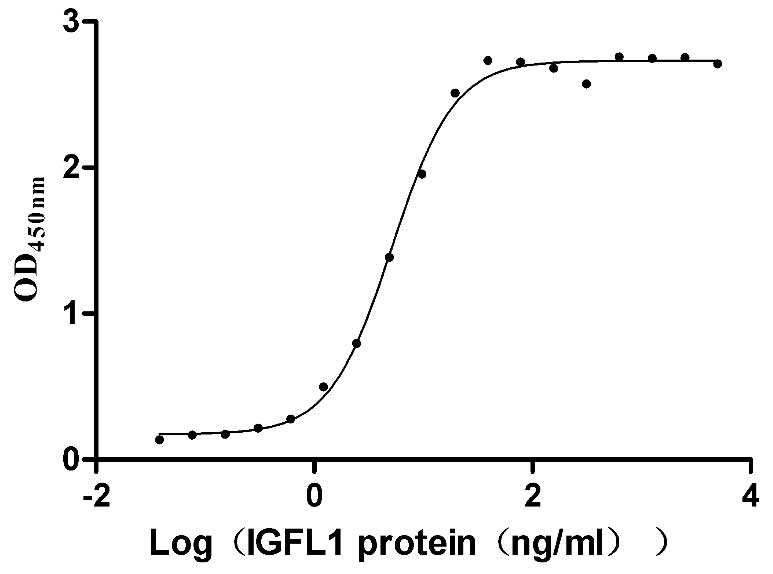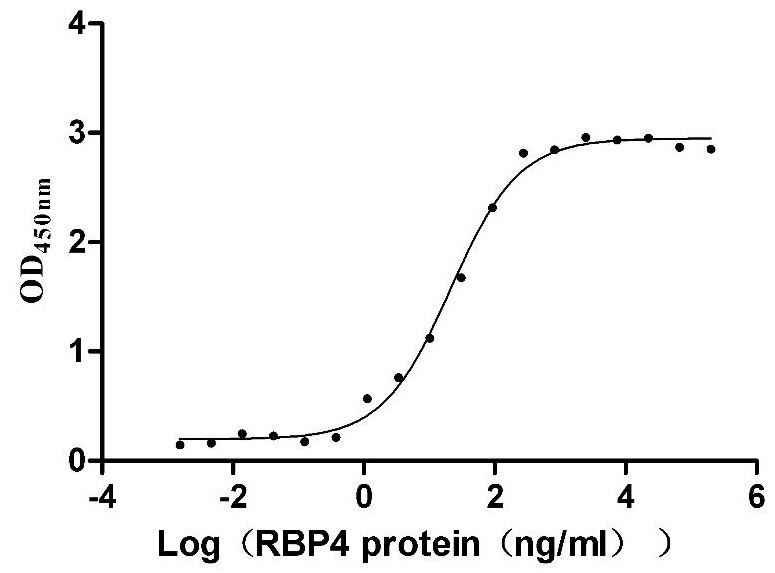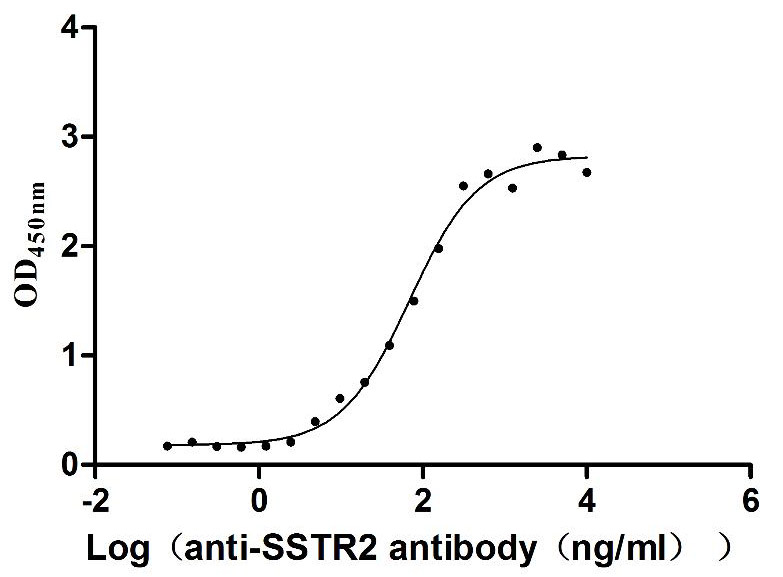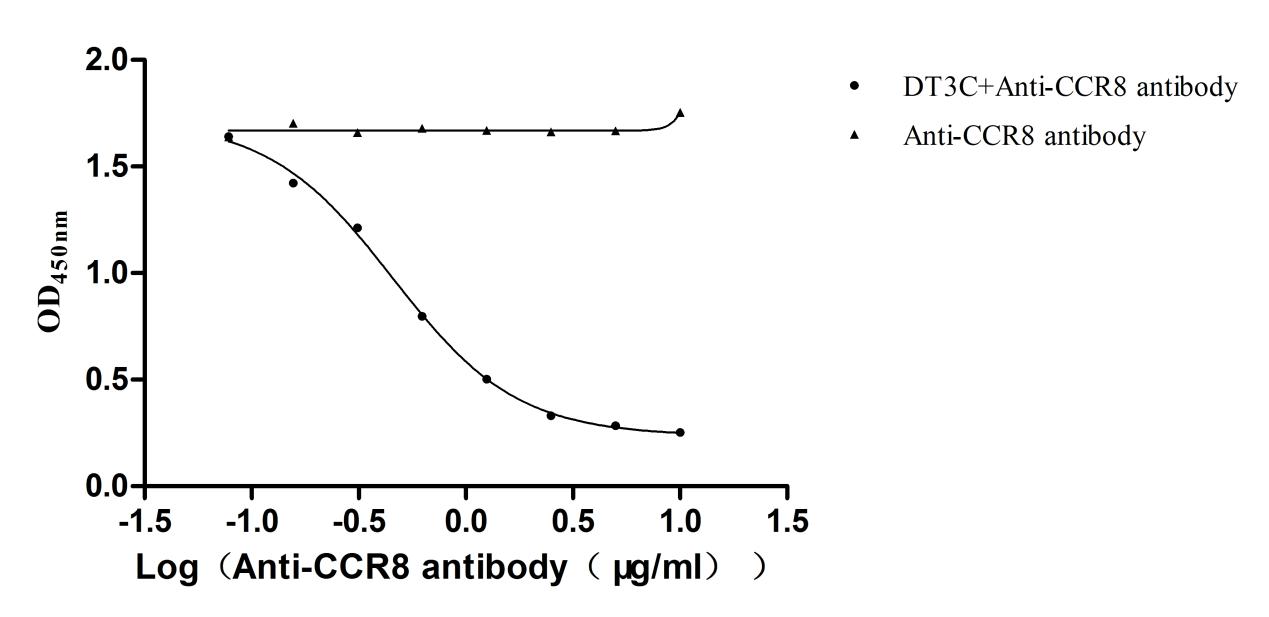Recombinant Mouse RE1-silencing transcription factor (Rest), partial
-
中文名称:小鼠Rest重组蛋白
-
货号:CSB-YP019571MO
-
规格:
-
来源:Yeast
-
其他:
-
中文名称:小鼠Rest重组蛋白
-
货号:CSB-EP019571MO
-
规格:
-
来源:E.coli
-
其他:
-
中文名称:小鼠Rest重组蛋白
-
货号:CSB-EP019571MO-B
-
规格:
-
来源:E.coli
-
共轭:Avi-tag Biotinylated
E. coli biotin ligase (BirA) is highly specific in covalently attaching biotin to the 15 amino acid AviTag peptide. This recombinant protein was biotinylated in vivo by AviTag-BirA technology, which method is BriA catalyzes amide linkage between the biotin and the specific lysine of the AviTag.
-
其他:
-
中文名称:小鼠Rest重组蛋白
-
货号:CSB-BP019571MO
-
规格:
-
来源:Baculovirus
-
其他:
-
中文名称:小鼠Rest重组蛋白
-
货号:CSB-MP019571MO
-
规格:
-
来源:Mammalian cell
-
其他:
产品详情
-
纯度:>85% (SDS-PAGE)
-
基因名:
-
Uniprot No.:
-
别名:Rest; Nrsf; RE1-silencing transcription factor; Neural-restrictive silencer factor
-
种属:Mus musculus (Mouse)
-
蛋白长度:Partial
-
蛋白标签:Tag type will be determined during the manufacturing process.
The tag type will be determined during production process. If you have specified tag type, please tell us and we will develop the specified tag preferentially. -
产品提供形式:Lyophilized powder
Note: We will preferentially ship the format that we have in stock, however, if you have any special requirement for the format, please remark your requirement when placing the order, we will prepare according to your demand. -
复溶:We recommend that this vial be briefly centrifuged prior to opening to bring the contents to the bottom. Please reconstitute protein in deionized sterile water to a concentration of 0.1-1.0 mg/mL.We recommend to add 5-50% of glycerol (final concentration) and aliquot for long-term storage at -20℃/-80℃. Our default final concentration of glycerol is 50%. Customers could use it as reference.
-
储存条件:Store at -20°C/-80°C upon receipt, aliquoting is necessary for mutiple use. Avoid repeated freeze-thaw cycles.
-
保质期:The shelf life is related to many factors, storage state, buffer ingredients, storage temperature and the stability of the protein itself.
Generally, the shelf life of liquid form is 6 months at -20°C/-80°C. The shelf life of lyophilized form is 12 months at -20°C/-80°C. -
货期:Delivery time may differ from different purchasing way or location, please kindly consult your local distributors for specific delivery time.Note: All of our proteins are default shipped with normal blue ice packs, if you request to ship with dry ice, please communicate with us in advance and extra fees will be charged.
-
注意事项:Repeated freezing and thawing is not recommended. Store working aliquots at 4°C for up to one week.
-
Datasheet :Please contact us to get it.
靶点详情
-
功能:Transcriptional repressor which binds neuron-restrictive silencer element (NRSE) and represses neuronal gene transcription in non-neuronal cells. Restricts the expression of neuronal genes by associating with two distinct corepressors, SIN3A and RCOR1, which in turn recruit histone deacetylase to the promoters of REST-regulated genes. Mediates repression by recruiting the BHC complex at RE1/NRSE sites which acts by deacetylating and demethylating specific sites on histones, thereby acting as a chromatin modifier. Transcriptional repression by REST-CDYL via the recruitment of histone methyltransferase EHMT2 may be important in transformation suppression. Represses the expression of SRRM4 in non-neural cells to prevent the activation of neural-specific splicing events and to prevent production of REST isoform 2. Repressor activity may be inhibited by forming heterodimers with isoform 2, thereby preventing binding to NRSE or binding to corepressors and leading to derepression of target genes. Also maintains repression of neuronal genes in neural stem cells, and allows transcription and differentiation into neurons by dissociation from RE1/NRSE sites of target genes. Thereby is involved in maintaining the quiescent state of adult neural stem cells and preventing premature differentiation into mature neurons. Plays a role in the developmental switch in synaptic NMDA receptor composition during postnatal development, by repressing GRIN2B expression and thereby altering NMDA receptor properties from containing primarily GRIN2B to primarily GRIN2A subunits. Acts as a regulator of osteoblast differentiation. Key repressor of gene expression in hypoxia; represses genes in hypoxia by direct binding to an RE1/NRSE site on their promoter regions. May also function in stress resistance in the brain during aging; possibly by regulating expression of genes involved in cell death and in the stress response. Repressor of gene expression in the hippocampus after ischemia by directly binding to RE1/NRSE sites and recruiting SIN3A and RCOR1 to promoters of target genes, thereby promoting changes in chromatin modifications and ischemia-induced cell death. After ischemia, might play a role in repression of miR-132 expression in hippocampal neurons, thereby leading to neuronal cell death.; Binds to the 3' region of the neuron-restrictive silencer element (NRSE), with lower affinity than isoform 1. Exhibits weaker repressor activity compared to isoform 1. May negatively regulate the repressor activity of isoform 1 by binding to isoform 1, thereby preventing its binding to NRSE and leading to derepression of target genes. However, in another study, does not appear to be implicated in repressor activity of a NRSE motif-containing reporter construct nor in inhibitory activity on the isoform 1 transcriptional repressor activity. Post-transcriptional inactivation of REST by SRRM4-dependent alternative splicing into isoform 2 is required in mechanosensory hair cells in the inner ear for derepression of neuronal genes, maintenance of hair cells and hearing.
-
基因功能参考文献:
- Findings identified REST as the first epigenetic modifier involved in promoting not only neuroendocrine differentiation but also EMT and stemness in advanced prostate cancer upon its downregulation. PMID: 28256535
- REST has a central role in maintaining both the quiescent and proliferation states of adult hippocampal neural stem cells by binding and regulating distinct target genes. PMID: 27819263
- Modulation of nuclear REST by alternative splicing is a potential therapeutic target for Huntington's disease. PMID: 28524599
- Negative regulation of REST on NR2B in spinal cord takes part in the exacerbation of bone cancer pain. PMID: 27732941
- Findings provide evidence for the loss of globin-linked neuroprotection to be linked to Alzheimer's disease angiopathogenesis, while raising the possibility of REST/ NRSF being an upstream regulator. PMID: 28391636
- a new paradigm of transcriptional regulation critical for cardiac development and maturation that is controlled by the interaction of REST, DNMT3B and non-CpG methylation. PMID: 27956497
- results highlight the significance of REST function in lens fiber formation, which is necessary for maintaining an intact lens structure PMID: 27631609
- Repressor element-1 silencing transcription factor levels affect the functional expression of voltage dependent calcium channels and the migratory activity in immortalized gonadotropin hormone releasing neurons. PMID: 27349310
- Data indicate that levels of repressor element-1 silencing transcription factor (REST) are elevated in polyubiquitin-B knockout (Ubb -/-) cells. PMID: 28285139
- Results identified REST as a novel target gene that was negatively regulated by miR-218 in cardiomyocytes hypertrophy process. PMID: 27258257
- Detailed analysis of specific lineage markers expression showed selective downregulation of endoderm markers in REST-null cells, thus contributing to a loss of cardiogenic signals. REST regulates cardiac differentiation of ESCs by negatively regulating the Wnt/beta-catenin signaling pathway and positively regulating the cardiogenic TF Gata4 PMID: 26864965
- These results suggest that REST-mediated chromatin remodeling is required in neural progenitors for proper S-phase dynamics, as part of its well-established role in repressing neuronal genes until terminal differentiation. PMID: 26745185
- The transcriptional repressor REST represses miR-21 and, thus, regulates self-renewal in E14Tg2a.4 mESCs cultured in the absence of mouse embryonic fibroblast feeder cell effects. PMID: 26209818
- Data suggest that Rest regulates early osteoblast differentiation via modulating Rest expression that is independent of Osx expression. PMID: 25727884
- Cultured astrocytes gradually became refractory to reprogramming, in part by the repressor REST preventing Neurog2 from binding to the NeuroD4 promoter. PMID: 26119235
- REST expression in nerve injury is decreased following alternative splicing which in turn controls PACAP expression. PMID: 26518165
- REST knockdown affects the capacity of progenitor cells to generate neurospheres in the subventricular zone. PMID: 25691247
- REST regulates differentiation and maturation of neural progenitor cells. PMID: 26538656
- the expression of REST during the early neural crest specification stage was necessary for the normal development of melanoblasts to cover all of the skin. PMID: 25818501
- We propose a mechanism for transcriptional activation in neurons that involves REST-guided targeting of TET3 to the DNA for directed 5hmC generation and NSD3-mediated H3K36 trimethylation PMID: 25843715
- transcriptional repressor REST is active in pancreas progenitors where it gates the activation of part of the beta cell differentiation program PMID: 26156633
- miR-9-mediated downregulation of the transcriptional repressor REST is essential for proper dendritic growth. PMID: 25406064
- Genes under REST control are actively repressed in stem cells by a balance of the H3K4me3 mark and a repressor complex that relies on histone deacetylase activity. PMID: 25250711
- p120-catenin regulates REST and CoREST and modulates mouse embryonic stem cell differentiation. PMID: 25074806
- Rest knockout mice do not have proper gastric retention and the reduction of acetylcholinesterase activity in NCC-derived myenteric plexus in the stomach was detected. PMID: 25135772
- CTDSP1 activity stabilizes REST in stem cells and ERK-dependent phosphorylation combined with Pin1 activity promotes REST degradation in neural progenitors. PMID: 25197063
- miR-22 and miR-124 are expressed in the cortical wall where they target components of the CoREST/REST transcriptional repressor complex, thereby regulating doublecortin transcription in migrating neurons. PMID: 24794437
- Higher REST levels resulted in lower levels of target genes, indicating that REST can fine-tune gene expression through repression. PMID: 25505318
- RE1-silencing transcription factor acts because it is bound in close proximity to SREBP, thus amplifying its ability to upregulate 24-dehydrocholesterol reductase PMID: 24861183
- increased REST/NRSF expression and its effect on the regulatory region for choline acetyltransferase (ChAT) transcription could explain the decreased expression of ChAT in the Alzheimer's disease transgenic mouse PMID: 25261598
- As a result of differences in the components and targets of the Rest complex, its functional roles may differ in embryonic stem cells and epiblast stem cells. PMID: 24752154
- Identification of a broad range of genes modulated by REST in mouse liver. PMID: 24329414
- findings show that nSR100 plays a role in the alternative splicing of REST in small cell lung cancer (SCLC); study provides new insight into the role of nSR100 in the expression of sREST, possibly in the pathogenesis of SCLC PMID: 23928058
- Our results reveal REST and microRNA dependent mechanisms that restrict NPAS4 expression to the brain PMID: 24291638
- results identify REST/NRSF as a critical factor linking neuronal activity to the activation of intrinsic homeostasis and restoring a physiological level of activity in the entire neuronal network PMID: 24149584
- miR-124 promotes neuronal survival under ischemic conditions via Usp14-dependent REST degradation. PMID: 23754622
- REST as a crucial transcriptional regulator for the Kv7.4 potassium channel subunit. PMID: 23242999
- REST knockout mice exhibit increased vulnerability to neurotoxicity of MPTP compared to wildtype. PMID: 22766071
- A conserved region of human and mouse SYN1 promoters contains cis-sites for the transcriptional activator Sp1 in close proximity to REST binding motifs. PMID: 23250796
- Evidence is provided of the contribution of inappropriate REST-mediated transcriptional repression to the widespread changes in coding and non-coding gene expression. PMID: 23145961
- REST regulates ESC pluripotency in culture condition- and ESC line-dependent fashion PMID: 22952733
- finding suggested that REST promoted primordial germ cells survival via regulation of the Mek5 expression PMID: 23022299
- central role for REST during neural development in promoting neural stem/progenitor cell self-renewal while restricting the generation and maturation of neurons and oligodendrocytes PMID: 22791895
- threshold dose of pentylenetetrazol that induced clonic and tonic seizures was significantly higher in NRSF conditional knock-out mice compared with controls. Median lethal dose of PTZ in NRSF cKO mice was considerably higher than that of control mice. PMID: 22472570
- Data show that Egr1-induced activation of the Ca(V)3.2 promoter was effectively counteracted by the repressor element 1-silencing transcription factor (REST). PMID: 22431737
- REST acts as a regulatory hub that coordinates timely repression of pluripotency with neural induction and neural differentiation. PMID: 22162260
- The Neural-restrictive silencer was located downstream of the transcription start site, and showed a position-dependent repressing activity. PMID: 21705344
- Data show that Rest plays a role in suppressing the expression of neuronal genes in cultured neuronal cells in vitro, as well as in non-neuronal cells outside of the central nervous system, but that it is dispensable for embryonic neurogenesis in vivo. PMID: 22241837
- NRSF, specifically REST4, may protect the developing brain from ethanol, providing new evidence that NRSF can be a therapeutic target in fetal alcohol syndrome (FAS). PMID: 21396985
- The data indicated that the residue cysteine 397 (Cys397) plays important roles in the global folding of NRSF/REST multiple ZnFs domain. PMID: 21951847
显示更多
收起更多
-
亚细胞定位:Nucleus. Cytoplasm.; [Isoform 2]: Nucleus.
-
组织特异性:Expressed in the hippocampus, including quiescent neuronal progenitor (QNP) cells, transient-amplifying progenitor (TAP) cells, neuroblasts and mature neurons (at protein level). Expressed in embryonic stem cells (at protein level). Expressed in many non-
-
数据库链接:
Most popular with customers
-
Recombinant Human IGF-like family receptor 1 (IGFLR1), partial (Active)
Express system: Mammalian cell
Species: Homo sapiens (Human)
-
Recombinant Mouse Transthyretin (Ttr) (Active)
Express system: Mammalian cell
Species: Mus musculus (Mouse)
-
Recombinant Human Somatostatin receptor type 2 (SSTR2)-VLPs (Active)
Express system: Mammalian cell
Species: Homo sapiens (Human)
-
Recombinant Human Urokinase-type plasminogen activator(PLAU) (Active)
Express system: Mammalian cell
Species: Homo sapiens (Human)
-
Recombinant DT3C (Diphtheria toxin & spg 3C domain) for Antibody Internalization Assay (Active)
Express system: E.coli
Species: N/A
















